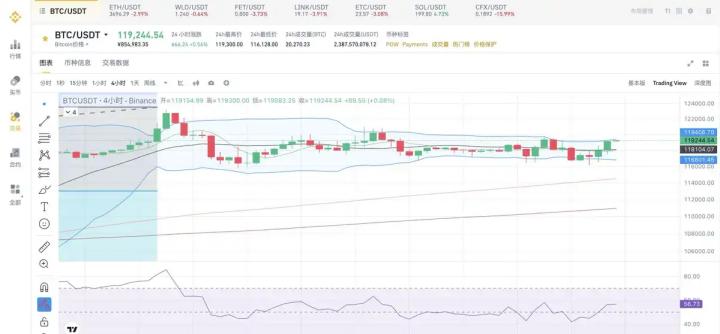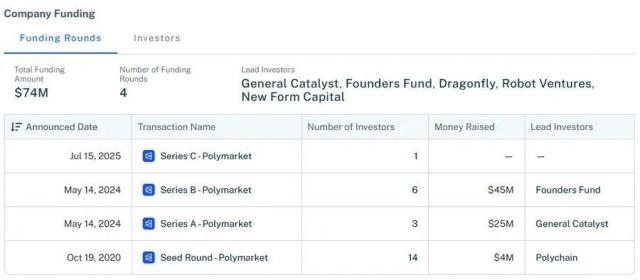Old Wang, a veteran who has been navigating the A-share market for nearly twenty years, always talks about price-to-earnings ratio, moat, and value investing. Three years ago, if you mentioned Bitcoin to him, he would shake his head like a rattle and blurt out two words: "Scam". During meals, he would lecture you in a patronizing tone, earnestly telling you that it lacks "fundamentals" and is purely a greater fool's game that would ultimately end in chaos. However, at a recent gathering, after a few drinks, Old Wang took out his phone and mysteriously began researching cryptocurrency: "What was that BlackRock Bitcoin ETF code again? And what exactly is this Meme thing they're talking about?"
With BTC reaching new highs and ETH breaking through, the originally separate "crypto traders" and "stock traders" have started to intersect—crypto enthusiasts are working to break out of their circle, more frequently explaining consensus and value to outsiders, possibly feeling that this matter is finally worth being understood by more people; on the stock market side, many are quietly eyeing BTC and ETH, saying they're "just casually looking" while actually allocating a small portion.
This trend didn't suddenly emerge. On one side, the White House, Wall Street, and regulatory bodies are getting involved; on the other, crypto companies are proactively discussing compliance and cooperation. After BTC hit new highs, the invisible barrier between crypto and traditional markets visibly softened—a two-way breakthrough began. So who is influencing whom now? Is the crypto circle trying to introduce crypto narratives into the mainstream? Or are traditional industries beginning to reunderstand Web3?
I. Outsiders Want to Enter: Wall Street, White House, and Institutions All Joining In
The changes this year are quite obvious. It's not that insiders are just trading enthusiastically, but that outside hands are reaching in one by one. Capital is betting, policies are loosening, and votes are tilting—these "outsiders" are clearly not here to just observe, but to participate. And they're accelerating in a way they weren't before.
[The translation continues in this manner, maintaining the specified translations for specific terms and ensuring a professional, accurate English rendering of the original text.]To truly break through, brand exposure alone is not enough; more importantly, gaining mainstream trust and regulatory approval is crucial. Therefore, major crypto giants have been investing resources in recent years to apply for compliance licenses in major global markets and establish legal operating frameworks. In this regard, Coinbase is a veteran pioneer on the compliance path. Listed on NASDAQ in 2021 as the first publicly listed crypto trading platform, this is backed by its years of solid compliance investments - MSB licenses in multiple U.S. states, BitLicense in New York, MiCA license in Europe, FCA registration in the UK, with a compliance network already well-established. Additionally, OKX can be considered one of the most aggressive trading platforms. At the beginning of 2025, it first reached a settlement with the U.S. Department of Justice, clearing historical baggage and laying the groundwork for returning to the U.S. market, and subsequently obtained high-value licenses such as Dubai VARA, Singapore MPI, and EU MiCA licenses, essentially opening up compliance entry points in Asia-Pacific, European, and American mainstream markets.
Many trading platforms that emerged during the Web3 wave are now starting to make up for compliance shortcomings. Although not the first batch of compliance advocates, their attitude has changed, and the direction is clear. This is not just about legal operation, but a new watershed: platforms that can go the distance are not competing on marketing tactics, but on whether they can operate under regulatory oversight. Those with licenses can enter the traditional financial table; those without can only remain in their own circle.
Besides gaining points through brand and licenses, the crypto industry has also been active. Products like OKX Wallet are working to open up Web3 entry points, allowing ordinary users to not just hear concepts but actually easily use blockchain services. Most notably, more and more crypto protocols are promoting RWA development, enabling users to buy and sell Tesla, NVIDIA stocks, or traditional financial assets like bonds on-chain. This is not just an innovation in gameplay, but also opens the door for more global users to fairly participate in traditional finance. In the past, buying U.S. stocks required complex procedures, but now with on-chain tokens, many crypto users can easily enter the market.
The crypto industry is taking the initiative to break through: enhancing brand influence through cross-industry collaboration, winning mainstream trust through compliant operations, and connecting reality with virtual through product innovation. These efforts have already shown initial results - now you can see crypto company advertisements in New York's Times Square and London streets; ordinary people can easily access decentralized financial services through mobile wallets.
III. When Crypto Meets U.S. Stocks, Who Will Change Whom?
When crypto meets U.S. stocks, a question quietly becomes important: Is crypto trying to push its narrative into the mainstream, or are traditional industries beginning to reunderstand Web3?
The crypto industry speaks of native on-chain transaction logic, asset liquidity, and the possibilities of open finance, thereby reshaping financial infrastructure. For example, the rise of DeFi allows anyone to borrow, trade, and manage finances without banks, directly challenging traditional banking services. Similarly, stablecoins, as "digital cash" in the crypto world, have begun to shine in cross-border payments and trade settlements. These demonstrate crypto technology's breakthrough in traditional financial infrastructure: transactions can be 24/7 uninterrupted, settlements can be completed in seconds, and anyone with internet can participate, no longer constrained by traditional institutions' operating hours and access thresholds. It can be foreseen that the underlying architecture of future financial systems may gradually become blockchain-based.
While crypto attempts to change traditional systems, traditional forces are profoundly changing crypto. The most obvious is regulatory intervention: governments and financial regulators are accelerating the formulation of regulations for cryptocurrencies, incorporating them into existing regulatory frameworks. Moreover, the large-scale entry of traditional capital may change the power dynamics in the crypto field. When Wall Street giants become the largest Bitcoin holders, when listed companies' boards decide to include Ethereum in their balance sheets, the pricing power and discourse rights of the crypto market have shifted to some extent to traditional institutions. This is somewhat ironic for crypto idealists who initially advocated decentralization and anti-authoritarianism, but it is an unavoidable process for the industry to go mainstream.
For the crypto industry, gaining traditional recognition means a larger user base and capital pool; for traditional finance, absorbing crypto innovation can improve efficiency and expand business boundaries. Therefore, rather than saying who breaks through whom, it's more about a new stage of two-way integration. In this integration process, two keywords run throughout - innovation and compliance. Only by adhering to innovation can new value and growth points be continuously created, attracting attention from outside the circle; only by embracing compliance can mainstream trust and support be gained, integrating into existing systems. These two are complementary and indispensable.
On one hand, innovation is the fundamental driving force for breakthrough. Since its birth, the crypto industry has been driven by continuous technological and model innovations. From Bitcoin's decentralized ledger to Ethereum's smart contracts, to emerging concepts like DeFi, Non-Fungible Token, and DAO, each innovation has expanded the industry's boundaries and attracted new participants. At the current stage, the industry needs truly disruptive killer applications. This could be an entirely new financial service model that makes traditional finance pale in comparison, or a platform connecting the real world, making people's daily lives more convenient through blockchain. For example, if ordinary people can easily complete cross-border digital asset payments with stablecoins, settling in seconds with almost zero fees, traditional remittance services would need to innovate, and many non-crypto users would naturally flow into the crypto ecosystem. Or when blockchain-based identity verification and data sharing mechanisms are widely applied, people no longer need to repeatedly submit cumbersome proof materials, significantly improving efficiency, then even if these users don't trade crypto, they have already become part of the blockchain world.
On the other hand, compliance is a necessary condition for breakthrough. For the crypto industry to truly break through, it must solve the trust issue, and compliance is key to building trust. In the past few years, we've seen too many irregularities due to lack of regulation: trading platforms running away, Ponzi schemes, hacker attacks, and losses. These events not only harm investors but also create negative impressions of cryptocurrencies in traditional society. Therefore, the industry must proactively embrace regulation, increase transparency and accountability. Fortunately, more and more crypto enterprises have realized this. They actively apply for licenses, improve risk control systems, and cooperate with regulatory bodies to combat illegal activities. This transformation gradually eliminates doubts from mainstream institutions and ordinary people, making them willing to try crypto services. Compliance may restrain some "wildness", but it allows the crypto world to run more steadily and further.
When Wall Street banks no longer look coldly on, when listed companies treat ETH as cash flow, when regulators start "laying tracks" for the industry, you can't view the crypto world of 2025 with 2020 eyes. Bubbles may still exist, but consensus has been rewritten: traditional banks begin offering crypto custody and trading services, crypto trading platforms obtain banking licenses to conduct deposit and loan business; stocks, bonds, and other assets are issued and traded on blockchain, crypto currency ETFs and futures become part of mainstream investment portfolios. Users can freely switch and allocate between crypto and traditional assets, with technology ensuring all transactions and settlements occur in a transparent, secure environment. These scenarios are already glimpsed today and will become increasingly common in the future.
Click to learn about BlockBeats job openings
Welcome to join the BlockBeats official community:
Telegram Subscription Group: https://t.me/theblockbeats
Telegram Communication Group: https://t.me/BlockBeats_App
Twitter Official Account: https://twitter.com/BlockBeatsAsia






